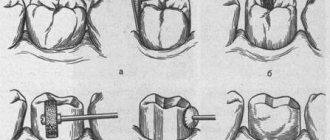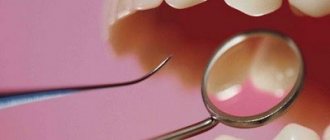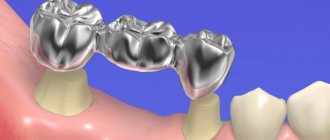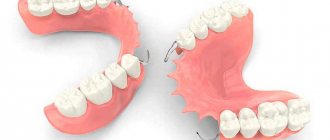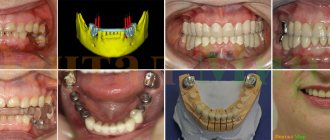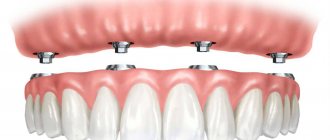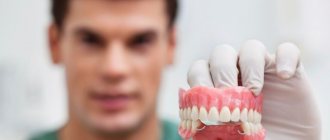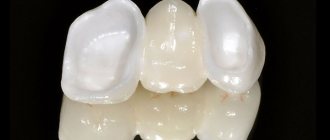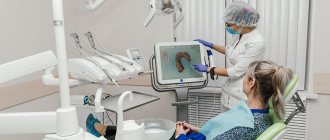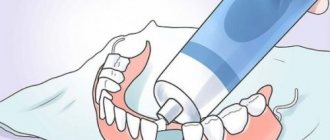Sometimes in dentistry a moment arises when a regular filling is not enough, but covering a tooth with a crown is still blasphemous. Then a diverse group of tabs comes to the rescue. Diverse in types and manufacturing methods. Inlays are prostheses (or microprostheses) that restore defects in the hard tissues of teeth, and as a result, the function and aesthetics of individual teeth and the entire dental system.
But they are not common. Not that they are extremely rare, but like marginals, they are on the border of two large restoration paths, and each of them is trying to occupy a large niche. On the one hand, these are fillings that are made here and now, quite quickly and cost-effectively. Another niche is crowns, which are used for more significant defects, and also occur in cases where an inlay can be used, but due to their higher functional qualities, longer service life and better aesthetics, they are more widespread among doctors.
Then why do we need them? But because they are more perfect than fillings in functional terms, and are more tolerant of tooth tissues than crowns, but in a harsh market they find themselves in the background.
Types of tabs
Among a number of classifications of inlays, the classification of the American Dental Association ADA stands out. On the one hand, this is due to the big name of the organization that has entered itself above the classification. On the other hand, it divides different types of inlays in a way that is more significant from a practical point of view than simply referring to the location of the hard tissue defect.
So, according to ADA, tabs are classified into 4 types:
- Inlay
- Onlay
- Overlay
- Pinlay
Inlay
The simplest type of tab, in which one or more surfaces are restored, but the main thing! without restoration of the tubercles. According to the name “inlay”, the tab lies inside the tooth. From a functional point of view, this is important, since in this case the tab is, as it were, sandwiched between the tubercles. In this case, even when the side surfaces are restored, the load on the tab falls at an angle close to a straight line and does not lead to displacement of the structure, which determines its high viability. But it is precisely this type of inlay that is most severely oppressed by fillings. It is not difficult to restore such defects with filling material, and the price between a filling and an inlay varies significantly, which, while welcomed by the patient, also requires more time for its manufacture, which negatively affects medical preferences.
Onlay
In situations where one or more cusps are destroyed or do not represent functional value, they are covered with an inlay. Then some of the cusps of the tooth remain their own, and some are replaced by an inlay. And this is the main design feature of Onlay tabs. But alas, not a plus.
The biomechanics of the dental system is such that the cusps almost never take the load at a right angle. Unlike the occlusal surface in the fissure area, where the inlay is conditionally driven even further into the tooth, inlays with an overlapping cusp perceive the load in completely different directions. This provokes a capsizing moment. A conventional artificial crown, taking pressure on the cusps on one side, has a kind of anchoring on the other side, expressed in the overlap of the cusps, which are not subject to load at the moment. As a result, Onlay-type structures are in a kind of decompensation, when the pressure exerted is not counteracted by sufficient fixation. This causes significant damage to the reputation of this type of tab.
Overlay
A type of inlay in which all the cusps of the tooth are covered, which is why some authors equate them to crowns. The so-called equatorial crowns. The advantages in comparison with the previous type of crowns are obvious, and are due to the overlap of all the cusps. And here crowns are already competing with Overlay tabs.
The bottom line is that the larger the surface of the contacting surfaces, the stronger the fixation of the structure, which we remember from the school physics course. Crowns and overlays completely cover the occlusal surface of the tooth, and here they can only compete in the complete coverage of the lateral surfaces. This indicator is obviously better for crowns. And given that the crown is a cylinder, all the walls are united and close to parallelism, which significantly potentiates the mechanical adhesion of the artificial crown and the tooth stump. It simply doesn’t cost the doctor anything to prepare the walls a little more, place the preparation border under the gum or at its level and achieve significantly better fixation of the structure.
Pinlay
Pinlay is a special type of inlay that has a pin in its design, with the help of which there is better fixation in the hard tissues of the tooth. As a result, it can be applied to any type of inlay, on any tooth, is functionally justified, requires a little more skill, is a little more difficult to manufacture, and is rare.
My opinion is that the use of a pin can improve the fixation of a tooth inlay, and, provided that when a regular inlay becomes uncemented and falls out, the inlay with the pin will remain in place, and the lack of cement will be gladly filled by microorganisms and the carious process. And it turns out that de-cementation, acceptable in terms of regularity, will be a kind of prevention, provided that the dropped insert does not end up in the patient’s lungs or gastrointestinal tract.
In addition to the ADA classification, there are other classifications that involve linking the tab to the location of the defect. For example, to:
- Black classification with grades 5-6
- Boyanov classification with designation of mesial (M), distal (D) or occlusal (O) localization of the defect or their combination
- Kurlyandsky classification with 3 types of defect localization, intersecting with the previous classification.
Tabs are also classified depending on the material from which they can be made. They can do many things:
- Plastic
- All metal
- Combined metal-plastic or metal-ceramic
- All-ceramic
- Composite
But from the point of view of functional, aesthetic and economic value, the last two types of inlays currently have value. And here we are in a convenient position to compare the inlay and filling from two angles. By comparing a filling and a ceramic inlay, it is convenient to evaluate the difference in structures created from materials with different functional qualities. And when comparing a filling and a composite inlay, let’s see how structures made from the same materials, but under different conditions, differ.
Ceramic inlays
It’s quite funny when, comparing a composite filling and a ceramic inlay, you sing odes in honor of the latter, but in fact, in the vast majority of cases, we work with a composite filling.
However, ceramic masses, no matter what they are, and inlays made from them are superior in functional qualities to composite fillings. And this is due not only to the qualities of the material, but also to the various manufacturing processes. When making a filling in the laboratory, the technician has privileges, such as significantly greater mobility during modeling. This is, of course, better to compare in the context of composite indirect restorations, however, computer modeling, which is increasingly being introduced into everyday routine practice, in theory should significantly increase the percentage of the use of ceramics when replacing defects in hard dental tissues.
The main difference between ceramics and composites is the greater strength of the former, which obviously leads to a longer service life of indirect restorations. Today, there are many works and articles indicating that modern ceramics are harder than natural tooth enamel, which in turn prevents the physiological wear of the restoration, contributes to the rapid wear of one’s own teeth, and increases the risk of chipping from such disharmonies. However, after their wear, composite fillings still remain on the teeth and do not cause inconvenience to the patient. It is good if a motivated and responsible patient regularly visits the dentist and the fillings are maintained in satisfactory condition, but the percentage of return patients is high. In this case, fillings of unsatisfactory quality lead to changes in the dental system. First compensated, then subcompensated, etc.
This may sound exaggerated, but it is reality. Modern composite fillings have excellent aesthetic and functional qualities, but require greater responsibility from the patient, while the higher cost of the inlays, and the very fact of a more advanced design in the patient, will stimulate him to be more conscious of the condition of his oral cavity.
Composite Tabs
As mentioned earlier, in this section it is useful to consider the differences between a filling and an indirect restoration, that is, a composite inlay.
So, current treatment concepts and modern filling materials make it possible to create excellent restorations, incredibly aesthetic, with high strength properties, but more than two decades ago the main reasons for the failure of composite restorations in the future were formed:
- Open dentinal tubules
- Polymerization shrinkage
- Under-polymerized composite
- Undercured dentin adhesive
- Increased occlusal contact
- Microbial contamination of the treated surface
- Microbial contamination during depressurization
- No binding agent
- Insufficient strength of dentin adhesive
- Gap in the area of the pulpal floor
- Crown crack
- Overdried dentin
- Open proximal contact
And if many of these points depend on the scrupulousness and responsibility of the doctor and the correct choice of materials, the rest can be quite significantly affected by the production of a composite restoration indirectly.
Making the inlay indirectly, as I said before, gives us greater mobility and ease of use, which is especially important when creating an adequate contact point between the teeth and the filling-tooth boundary. Literally, this is already the filling-plaster boundary, but this can be found in such a plus as good visualization of the boundary, and as a result the creation of a neat marginal fit. Thus, we have a greater opportunity to avoid at least two complications - depressurization and open proximal contact.
Next, by polymerizing the inlay indirectly, after a short exposure, we can remove the restoration and continue polymerization from different sides, or from all of them at once when using a photobox. This is important to reduce the degree of shrinkage, which in any case occurs, to avoid the C-factor and the risk of under-polymerization of the composite. In a quick calculation, we reduce the risk of such complications as polymerization shrinkage, under-cured composite, depressurization (a lower degree of shrinkage directly affects this) and a gap in the area of the pulp floor (caused by polymerization shrinkage).
On the one hand, it may seem that adhesive preparation for indirect restoration has a high risk of complications associated with under-polymerization of the adhesive and all the ensuing consequences, but that’s what modern lamps, powerful lamps and the doctor’s understanding of the manipulation he is performing are for.
By modeling the inlay using the indirect method, it is undoubtedly easier for the doctor to correctly recreate the anatomy, but it will most likely require correction after fixation. However, before this, the patient did not sit with us for some time with his mouth open while we modeled the filling for him, and therefore he does not have that fatigue in the joint, sprains, and we can more accurately correct the occlusal contacts. And just correct it, since when using articulators we had an excellent opportunity to create them exactly as we needed in a specific clinical situation.
As a result, we have that indirect restorations can seriously exceed fillings in quality, but the latter are still much more popular. Of course, the point is that it is more labor intensive, and the seemingly small increase in quality is not worth the extra effort.
But what if we could combine the advantages of filling speed, design quality of indirect restorations and material quality of ceramic restorations? Today, progress does not stand still and, again, is being increasingly introduced into everyday routine practice. I'll touch on this in the next section.
What is a ceramic tooth inlay and how does it differ from fillings and core microprostheses?
To begin with, it is worth distinguishing between two concepts – stump and restoration inlay. The first is a microprosthesis, which with one part is fixed in the root canal, and the second protrudes above the gum and serves as a support for installing a crown. This orthopedic system represents the basis for further prosthetics or composite building, and is used in cases of serious destruction of the visible part of the tooth. Essentially, this is a more substantial and reliable version of the pin.
There is another type - restoration microprosthesis. It is intended to restore the missing fragment in the crown. Such a product is created in a dental laboratory using an impression. It may have a different shape, but it must exactly match the missing fragment. We can say that such an inlay is analogous to a large filling, only it is made using an indirect method in the laboratory. In addition, the filling is a therapeutic construction, and the inlay is already orthopedic.
Making a tab
Preparation for the manufacture of an inlay differs quite significantly from preparation for a composite direct restoration. We're not talking about a free cavity design. We need smooth, slightly diverging walls and a flat bottom, which can be leveled with a thin layer of restoration material. The angle between the walls and the bottom should be rounded to reduce stress on the material and hard tooth tissue in these areas. The cavity must be of sufficient size; weakened tooth tissues are excised to avoid further chipping. There are a huge number of these rules, which depend on the restoration material and the location of the defect, but there are the basic rules stated above. And the rest are determined by the doctor’s experience and the correct ability to assess the relevant clinical situation.
Next comes the impression. Modern materials make it possible to obtain two-layer one-stage prints of excellent quality, but this applies specifically to the materials. But with regards to modern technological solutions, we are taking a significantly different path and transferring the real state of affairs in the oral cavity into digital. To do this, we use intraoral optical scanners and the optical impressions they produce.
Next, we also model the inlay, pay special attention to the preparation border, proximal contacts, carefully check the occlusal contacts and remember the last century.
Today we will do it differently. Computer modeling will allow us not only to accurately model boundaries and contacts, but also to copy a tooth of the same name from the opposite side of the jaw, modify it to suit the situation in this area, create not just multiple occlusal contacts, but create them in the place we need, with the area and height required at micro levels. Yes, experienced doctors can do this with filling materials in the oral cavity, but not every one of us is a doctor with many decades of experience behind us. Moreover, ease of working with digital data and speed in working with digital data will definitely lead to a change in priorities in dentistry. Already leading. The modeled inlay is milled and sent to the office, or to the chair, since a milling machine in the office itself becomes commonplace.
If there are no such possibilities today, then we either polymerize the modeled composite inlay, or send a wax model of the inlay to replace it with ceramics.
Next, the tabs are fixed and the satisfied patient goes to stop chewing nuts.
Ceramic microprostheses: indications and contraindications
A similar method of microprosthetics is shown in a number of specific clinical cases. Here are the main ones:
- destruction of the visible part of the tooth by less than half (progressive caries, pulpitis, including complicated by periodontitis, trauma),
- the presence of a large cavity with thin walls on the chewing tooth,
- the need to replace old large fillings,
- the need to strengthen supporting elements for the installation of a bridge or removable denture.
If the causative element is destroyed by more than half or has retained less than two walls, this type of microprosthesis is not installed - it will not last long enough. Also, such solutions are rarely used on severely damaged front teeth. This option will also be unsuitable for primary molars and the last eights.
Inlays made of photopolymer light-curing material
Stages of installation of a microprosthesis
During the first visit, the specialist conducts a careful visual inspection of the damaged element and examines the X-ray image. Next, he selects the appropriate treatment vector. To begin with, be sure to treat the carious cavity, remove necrotic areas, disinfect and prepare hard tissues. If necessary, depulpation is performed (the nerve is removed), after which the doctor cleans and seals the canals. After the cavity has been fully prepared, the doctor takes impressions and sends them to the laboratory. Impressions are also taken from the antagonist tooth. This allows you to determine how the tab should be positioned so as not to interfere with the correct closure of the jaws. Until it is ready, the patient is given a temporary filling.
At the second visit, the temporary filling is removed and the orthopedic product is tried on. If there are no complaints and the structure does not need to be sent for correction, it is fixed with durable dental cement. The excess is removed, the surface of the crown is ground and polished.
Possible complications
The placement of the inlay is preceded by grinding down the tooth surface in order to remove tissues that are affected by caries. If the dentist has sufficient qualifications and experience, this procedure is problem-free.
But if the quality of cleaning is insufficient, when minor carious areas remain, there is a danger of secondary caries.
High tooth sensitivity can lead to another problem - the development of discomfort and the unpleasant sensation of the presence of a foreign object in the mouth after installation of the structure.
In isolated cases, the cavity itself is opened, which always leads to the insert falling out. In such a situation, you should immediately contact a specialist to re-fasten it or make a new one.
All of these complications occur very rarely, which confirms the quality of reconstruction of a damaged tooth with a ceramic inlay.
Material for making composites and their main advantages.
In this publication, read about the types of microdental dentures.
Here are real reviews about tooth inlays for a crown.
Varieties
Depending on the material used for manufacturing, the tabs have three types:
Microprostheses made of metal-ceramics are a new type of design that combines two types of materials - medical steel and porcelain. Their cost is almost on the same level as ceramic products, but, as practice shows, they are inferior in quality.
Metal-ceramic products quite often fall out due to a mismatch in the thermal expansion coefficient of materials (metal and porcelain). Therefore, this type of tab is rarely used.
To create structures from pressed ceramics, the technology of injection molding of the material is used with additional exposure to high pressure and temperature. The products are much stronger and more reliable than the previous model, and are considered ideal in appearance.
Zirconium dioxide samples differ from the listed varieties in their greatest strength. They are made by grinding zirconium blanks using automated equipment. Afterwards the product is fired and covered with ceramics.
The automation of the manufacturing process has an important influence on the quality of microprostheses, which eliminates the human factor.
What kind of design is this
A ceramic dental inlay is a microprosthesis1 that restores the integrity of a tooth when it is less than half destroyed. Such microprostheses are called “restorative inlays”, and they are installed not by dental therapists, but by orthopedic dentists (“prosthetists”). Externally, ceramic masonry looks like a piece of your own tooth - more precisely, the missing area on a natural crown, with all the tubercles and grooves-fissures. When a microprosthesis is fixed, it, like the last piece of a “puzzle,” restores the integrity of the tooth.
The resulting restoration looks very natural – indistinguishable from a “native” tooth. This is due to the properties of ceramics, which are now produced using advanced technologies - with natural light refraction, translucency, color and transparency transitions in different areas of the ceramic.
Restorative microprostheses are often compared to fillings or even confused with stump inlays. Next, we’ll tell you how they differ – after all, these are still different concepts.
Complex on 4 OSSTEM implants with delayed loading - 140,000 rubles.
Complex implantation Osstem (South Korea) with delayed loading after 4-6 months.
Doctor's work guarantee - up to 5 years (under an agreement on the provision of medical services) Call now or order a call
Opening hours: 24 hours a day - seven days a week
Price
As noted earlier, one of the disadvantages of ceramic structures is their price. This is explained by the high cost and quality of the material, as well as the complexity of the manufacturing process.
The price may fluctuate in different clinics, but the approximate figures look like this:
- metal-ceramic - about 8 thousand rubles;
- from pressed ceramics - about 14 thousand rubles;
- from zirconium dioxide – from 15 thousand rubles.
To these figures should be added payment for mandatory preparatory procedures, taking an impression, installing a microprosthesis, and this is approximately another 3-5 thousand.
Features of care and possible risks
As noted above, while the permanent orthopedic structure is being manufactured, the patient is given a temporary filling. During this period, you need to exercise increased caution and respect for your teeth. You will have to temporarily stop eating foods that are too hard and chewy, as well as responsibly maintain oral hygiene and remember to brush your teeth in the morning and evening.
In the future, after dentures, it is important to follow basic hygiene rules, including rinsing the mouth and using floss after each meal. It is better to refrain from potentially traumatic habits, such as opening bottles with your teeth and biting off thread. It is also equally important to visit the dentist every six months for preventive and professional care. hygiene.
As for the possible risks associated with the installation of a ceramic inlay, it should be noted that correctly installed products made from high-quality materials minimize the risk of developing any complications. To reduce this risk to virtually zero, the patient must follow the principles of hygiene described above. Typically, problems arise either through the fault of the patient himself or due to medical errors made during prosthetics:
- untreated inflammatory processes that continue to progress under the orthopedic system,
- the presence of contraindications to the installation of a microprosthesis that were ignored by the specialist,
- insufficiently careful choice of shade,
- errors in calculations and manufacturing of the product and, as a result, the appearance of microgaps in which plaque accumulates, provoking the development of acute inflammatory processes.
The service life of a restored element largely depends on its original condition. If a sufficient volume of living tissue is preserved (if not only the cavity remains, but also the walls of the crown), a composite inlay can last 3-4 years, and a ceramic or zirconium inlay can last 10 years or more, of course, provided that the technology for its installation is correct.
Pros and cons of ceramic products
Of course, the method under consideration has many advantages. The main advantages of this method of microprosthetics are listed below:
- a more reliable, wear-resistant and durable option than a large filling or restoration on a pin,
- preservation of shape and color throughout the entire service life,
- the ability to select the correct shade as accurately as possible through the use of high-quality dental ceramics,
- the ability to avoid the need to remove the nerve if there are no signs of inflammatory processes.
Ceramic indirect restoration is a more expensive option for restoring a damaged tooth than classic filling. On the other hand, this method gives a much more durable result, which fully compensates for the costs invested in it.
Ceramic restoration inlay
